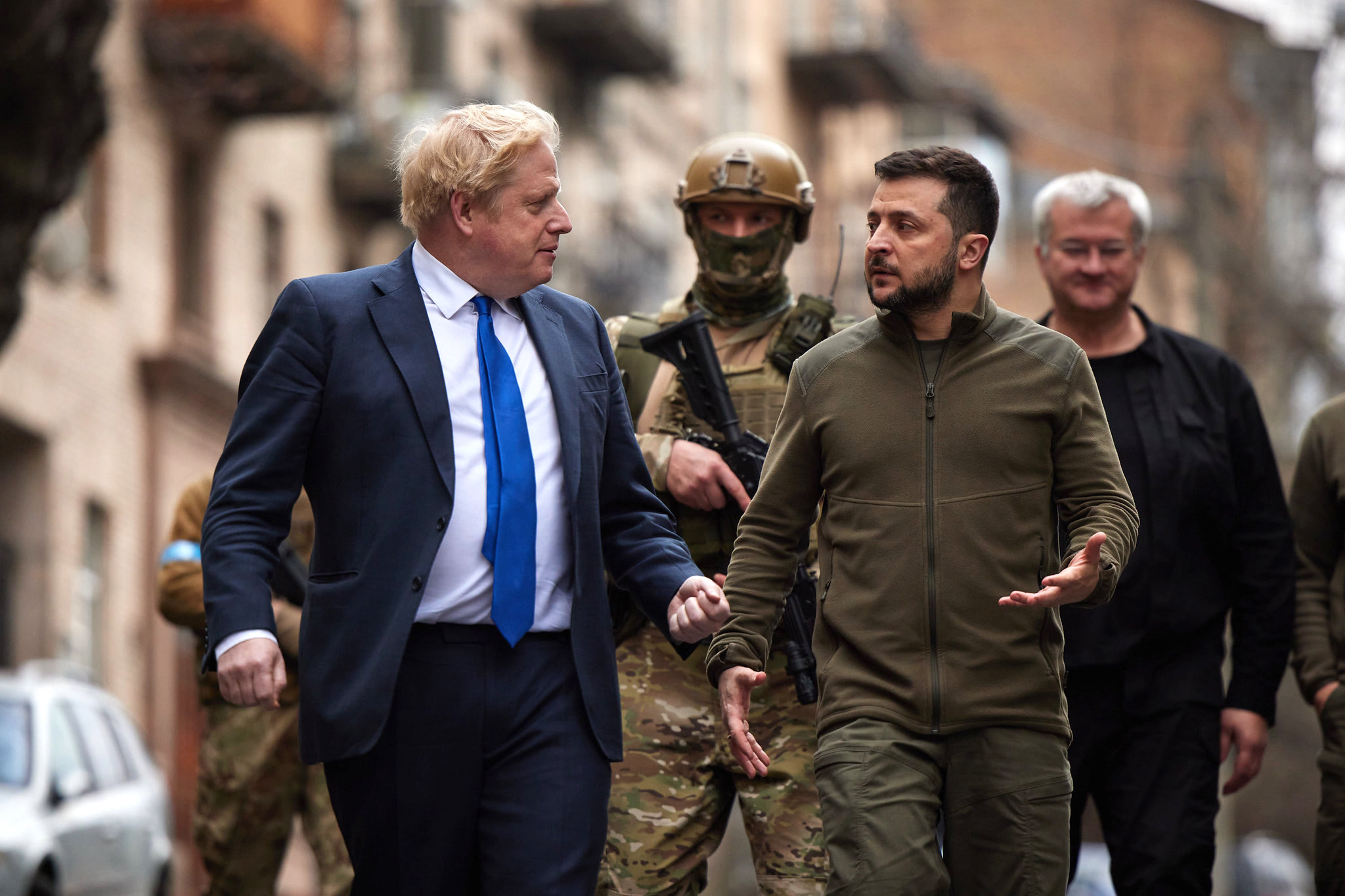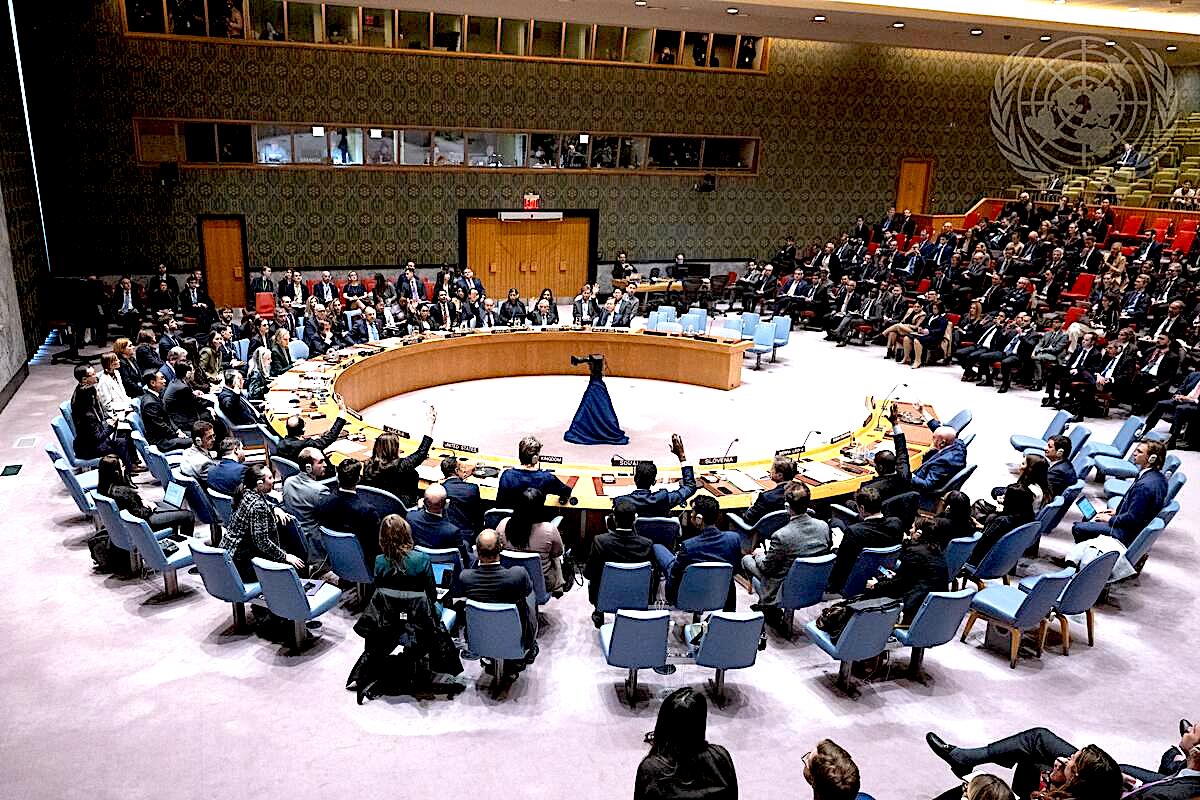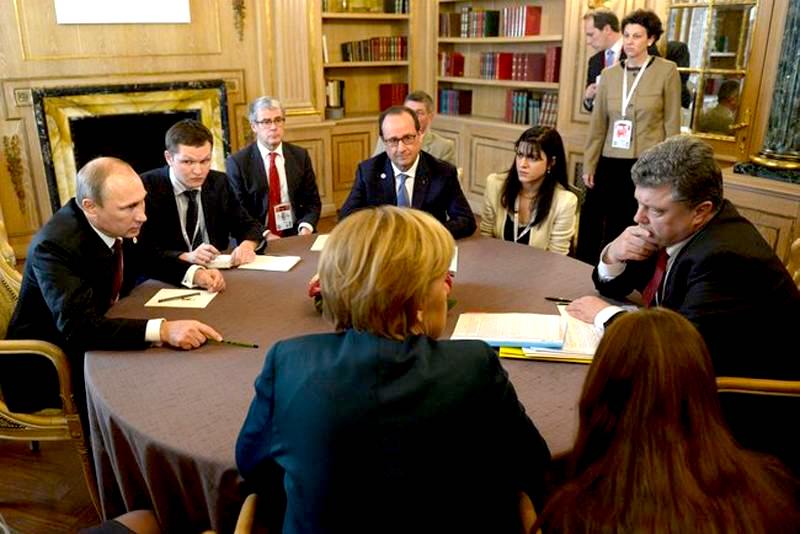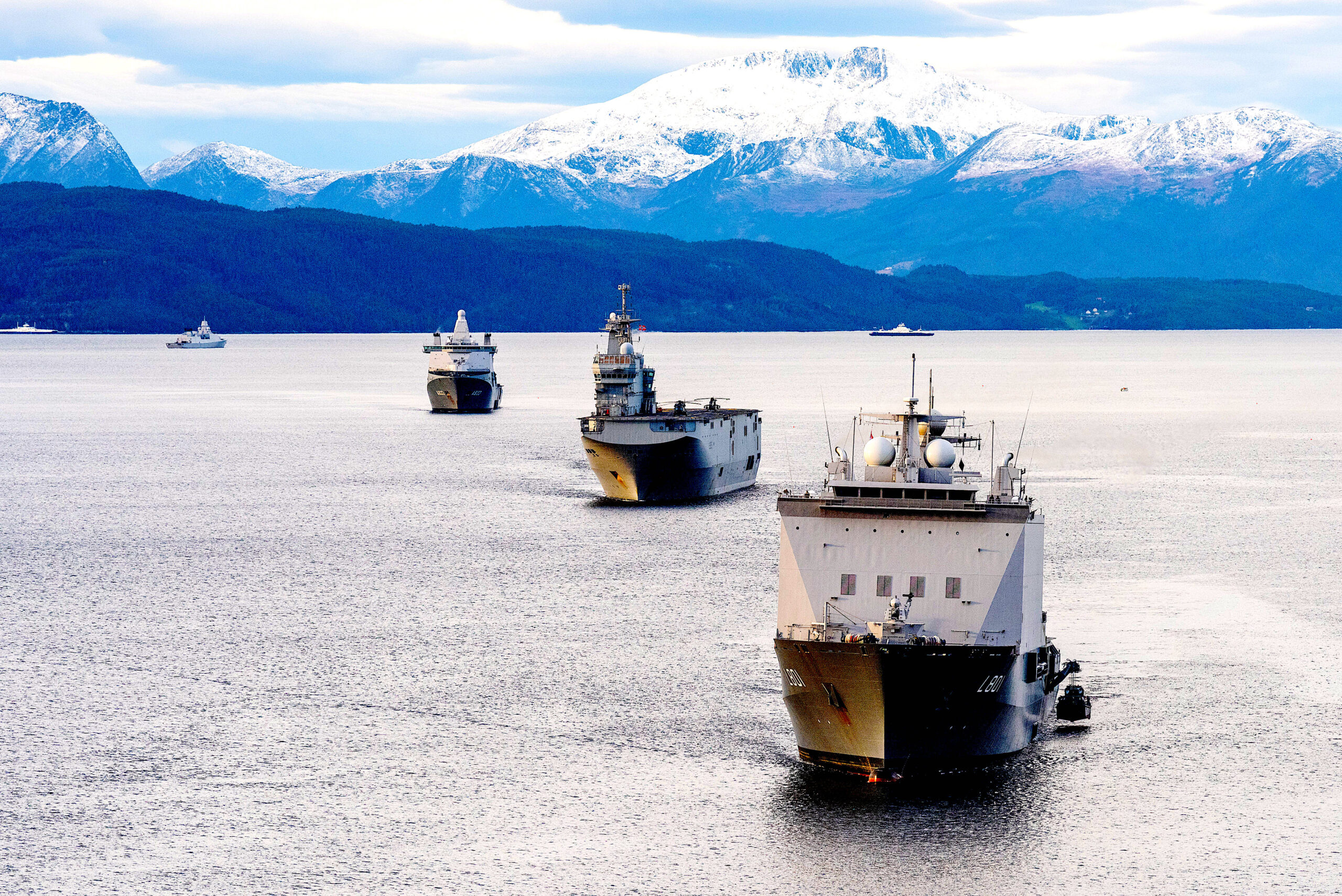Ukraine will have to cede more territory than it would have in April 2022 — when the U.S. and U.K. talked it out of a peace deal — but it will gain sovereignty and international security arrangements.

Russia’s President Vladimir Putin, Foreign Minister Sergei Lavrov and Kremlin Spokesman Dmitry Peskov in 2019. (Kremlin.ru, Wikimedia Commons, CC BY 4.0)
By Jeffrey D. Sachs
Common Dreams
 There should be little doubt about how a lasting peace can be established in Ukraine. In April 2022, Russia and Ukraine were on the verge of signing a peace agreement in Istanbul, with the Turkish government acting as mediator.
There should be little doubt about how a lasting peace can be established in Ukraine. In April 2022, Russia and Ukraine were on the verge of signing a peace agreement in Istanbul, with the Turkish government acting as mediator.
The U.S. and U.K. talked Ukraine out of signing the agreement, and hundreds of thousands of Ukrainians have since died or been seriously injured. Yet the framework of the Istanbul Process still provides the basis of peace today.
The draft peace agreement (dated April 15, 2022) and the Istanbul Communique (dated March 29, 2022) on which it was based, offered a sensible and straightforward way to end the conflict. It’s true that three years after Ukraine broke off the negotiations, during which time Ukraine has incurred major losses, Ukraine will eventually cede more territory than it would have in April 2022 — yet it will gain the essentials: sovereignty, international security arrangements, and peace.
In the 2022 negotiations, the agreed issues were Ukraine’s permanent neutrality and international security guarantees for Ukraine. The final disposition of the contested territories was to be decided over time, based on negotiations between the parties, during which both sides committed to refrain from using force to change boundaries.
Given the current realities, Ukraine will cede Crimea and parts of southern and eastern Ukraine, reflecting the battlefield outcomes of the past three years.

U.K. Prime Minister Boris Johnson and Ukraine’s President Volodymyr Zelensky walking around the center of Kiev on April 9, 2022. (President of Ukraine, Public domain)
Such an agreement can be signed almost immediately and in fact is likely to be signed in the coming months. As the U.S. is no longer going to underwrite the war, in which Ukraine would suffer yet more casualties, destruction and loss of territory, Ukraine President Volodymyr Zelensky is recognizing that it’s time to negotiate.
In his address to Congress, President Donald Trump quoted Zelensky as saying, “Ukraine is ready to come to the negotiating table as soon as possible to bring lasting peace closer.”
Security Guarantees
The pending issues in April 2022 involved the specifics of security guarantees for Ukraine and the revised boundaries of Ukraine and Russia.
The main issue regarding the guarantees involved the role of Russia as a co-guarantor of the agreement. Ukraine insisted that the Western co-guarantors should be able to act with or without Russia’s assent, so as not to give Russia a veto over the Ukraine’s security.
Russia sought to avoid a situation where Ukraine and its Western co-guarantors would manipulate the agreement to justify renewed force against Russia. Both sides have a point.
The best resolution, in my view, is to put the security guarantees under the authority of the U.N. Security Council. This means that the U.S., China, Russia, U.K. and France would all be co-guarantors, together with the rest of the U.N. Security Council. This would subject the security guarantees to global scrutiny.
Yes, Russia could veto a subsequent U.N. Security Council resolution regarding Ukraine, but it would then face China’s opprobrium and the world’s if Russia were to act arbitrarily in defiance of the will of the rest of the U.N.

U.N. Security Council members on Feb. 24 voting for Resolution 2774 imploring “a swift end to the conflict and further urges a lasting peace between Ukraine and the Russian Federation.” (UN Photo/Eskinder Debebe)
Regarding the final disposition of borders, some background is very important. Before the violent overthrow of Ukrainian President Viktor Yanukovych in February 2014, Russia did not make any territorial demands vis-à-vis Ukraine.
Yanukovych favored neutrality for Ukraine, opposed NATO membership, and peacefully negotiated with Russia a 20-year lease for Russia’s naval base in Sevastopol, Crimea, home of Russia’s Black Sea Fleet since 1783. After Yanukovych was toppled and replaced by a U.S.-backed, pro-NATO government, Russia moved quickly to retake Crimea, to prevent the naval base from falling into NATO hands.
During 2014 to 2021, Russia did not push for annexing any other Ukrainian territory. Russia called for the political autonomy of the ethnic Russian regions of eastern Ukraine (Donetsk and Luhansk) that broke away from Kyiv immediately after Yanukovych was toppled.
The Minsk II agreement was to implement autonomy. The Minsk framework was inspired in part by the autonomy of the ethnic Germany region of South Tyrol in Italy. German Chancellor Angela Merkel knew the South Tyrol experience and viewed it as a precedent for similar autonomy in the Donbas.
Unfortunately, Ukraine strongly resisted autonomy for the Donbas, and the U.S. backed Ukraine in rejecting autonomy. Germany and France, which ostensibly were guarantors of Minsk II, stood by silently as the agreement was thrown aside by Ukraine and the United States.

Oct. 17, 2014: Putin, left, in talks with Ukrainian President Petro Poroshenko, right, and Merkel and French President François Hollande. (Kremlin.ru, CC BY 4.0, Wikimedia Commons) [de
Following six years in which Minsk II was not implemented [despite its endorsement by the U.N. Security Council], during which the U.S.-armed Ukrainian military continued to shell the Donbas in an attempt to subdue and recover the breakaway provinces, Russia recognized Donetsk and Luhansk as independent states on Feb. 21, 2022.
The status of Donetsk and Luhansk in the Istanbul process was still to be finalized. Perhaps a return to Minsk II and its actual implementation by Ukraine (recognizing the autonomy of the two regions in the Ukrainian constitution) could have been ultimately agreed. When Ukraine walked away from the negotiating table, alas, the issue was moot. A few months later, on Sept. 30, 2022, Russia annexed the two oblasts as well as two others.
The sad lesson is this. Ukraine’s loss of territory would have been averted entirely but for the violent coup that toppled Yanukovych and brought in a U.S.-backed regime intent on NATO membership. The loss of territory in eastern Ukraine could have been averted had the U.S. pushed Ukraine to implement the U.N. Security Council-backed Minsk II agreement.
The loss of territory in eastern Ukraine could probably have been averted as late as April 2022 in the Istanbul Process, but the U.S. blocked the peace agreement.
Now, after 11 years of war since the overthrow of Yanukovych, and as a result of Ukraine’s losses on the battlefield, Ukraine will cede Crimea and other territories of eastern and southern Ukraine in the coming negotiations.
Baltic Concerns

Nov. 1, 2018: NATO joint country exercise in the North Atlantic and Baltic Sea. (NATO, Flickr)
Europe has other interests that it should be negotiating with Russia, notably security for the Baltic States and for European-Russian security arrangements more generally.
The Baltic States feel very vulnerable to Russia, understandably so given their history, but they are also gravely and unnecessarily adding to their vulnerability by a stream of repressive measures taken against their ethnic Russian citizenry, including measures to repress the use of the Russian language and measures to cut their citizens’ ties with the Russian Orthodox Church.
Baltic state leaders are also provocatively engaging in remarkable Russophobic rhetoric. Ethnic Russians are about 25 percent of the population of both Estonia and Latvia, and around 5 percent in Lithuania. Security for the Baltic States should be achieved through security-enhancing measures taken on both sides, including the respect for minority rights of the ethnic Russian populations, and by refraining from vitriolic rhetoric.
The time has arrived for diplomacy that brings collective security to Europe, Ukraine and Russia. Europe should open direct talks with Russia and should urge Russia and Ukraine to sign a peace agreement based on the March 29 Istanbul Communique and the April 15, 2022, draft peace agreement.
Peace in Ukraine should be followed by the creation of a new system of collective security for all of Europe, stretching from Britain to the Urals, and indeed beyond.
Jeffrey D. Sachs is a university professor and director of the Center for Sustainable Development at Columbia University, where he directed The Earth Institute from 2002 until 2016. He is also president of the U.N. Sustainable Development Solutions Network and a commissioner of the U.N. Broadband Commission for Development.
This article is from Common Dreams.
Views expressed in this article and may or may not reflect those of Consortium News.

The Ukraine has been gaining territory and losing territory one way or the other for hundreds of years. It was part of Russia or the USSR for those hundreds of years and it was in this condition that it gained and lost territory by the whim of different Russian leaders or through war. My point is that for the Ukraine to be a small land-locked area with no military is not a bad fate.
The Ukraine has been rumored to be the most corrupt country in the world since 1991, which is when the Ukraine began to be a country and manage its own affairs – due to the dissolution of the USSR in 1990-91. It is obvious that the Ukrainians cannot manage.
A small agrarian area is probably the best not only for the Ukrainians but for the rest of us.
“…Russia moved quickly to retake Crimea, to prevent the naval base from falling into NATO hands.””
Having family and extended family in that part of the world, we paid considerable attention to events in the Ukraine during that period. It seems to have been forgotten that, since independence in 1991, the Crimea had made two previous attempts to decamp from the Ukraine. It was an area gifted to the Ukraine in 1954 by Krushchev; clearly, the citizens were less than pleased at this, and wanted out. But, as a result of those attempts, the Crimea had a degree of autonomy. When Yanukovich was overthrown, the Crimean government held a plebiscite. Citizens voted overwhelmingly to return to Russia, so the government petitioned Russia for return. Obviously, Russia wasn’t averse to the return: Sevastopol is, after all, a warm-water port, and the Russian naval base. At the time, there were Russian troops stationed in the Crimea, under the terms of the Black Sea Fleet Treaty.
These events were reported at the time. If I recall correctly, even the BBC – not known for its lack of anti-Russia bias – reported on it.
“Russia launched its full-scale invasion of Ukraine in February 2022 at least in part to prevent its neighbour from becoming part of the west, including joining NATO.”
This is a simplistic statement, with an element of disingenuousness. The proximate trigger for Russian intervention in the Donbass was (we subsequently found out) Russian intel revealing Kiev’s intention to retake by force the republics of Donetsk and Lugansk. The Ukrainian army was concentrating forces on the border near Donetsk. Following the atrocity in Odessa in 2014, the Donbass republics had broken away from Kiev and declared independence. And since that stage, Kiev had been repeatedly bombarding that area, causing around 14,000 casualties and much destruction.
In my view, repetition of the claim about the Ukraine joining NATO and the West has been made ad nauseam, so as to render Kiev’s actions understandable. What, after all, could be so exceptionable about the Ukraine joining up with NATO and the West? Aren’t we the good guys?
” Putin has shown that he is capable of all manner of brutality…..”
It’s incumbent upon you to produce the evidence for this statement. As I understand the situation, Russia would have preferred no intervention in the Donbass. But it was inevitable. Nonetheless, Russia has gone out of its way to avoid civilian casualties. The same cannot be said of the Ukrainian forces, which is probably not surprising, given the influence of neo-Nazism in the Kiev government. The 2014 Odessa atrocity is indicative of that: a Nazi trick, if ever I saw one.
“The great deception of the mainstream media is that the people of Ukraine all want the same thing…”
I agree. MSM propaganda has left many people in my country – NZ – utterly ignorant, and completely bamboozled about what’s going on there. If we try to proffer a countervailing view, people counter with a propaganda talking point. We find it wearing, and ultimately futile to argue with them.
I also agree with the rest of your comment. The people of the Crimea and of the Donbass have made their desires clear. That area is Russophone, and they do not wish to return to Kiev.
On France’s outlay to Ukraine:
“Of the €200 million, €60 million will be allocated to support the energy sector, Svyrydenko said. ”
“The funding will help modernize outdated infrastructure, implement digital solutions, restore damaged facilities, diversify energy sources, and transition to green energy.”
hxxps://uatv.ua/en/ukraine-and-france-approve-reconstruction-projects-under-e200-million-agreement/
Going green in Ukraine, with borrowed money, is not going to work any better in Ukraine than it has in Germany.
I thought that the people of Crimea voted in a referendum to become part of Russia. Is that true?
On that note, has anyone asked the people of the Eastern provinces what they want?
Oh~~I tip my hat to Jeffrey Sachs!
Logically, the United Nations Security Council is the best authority to arrange security guarantees, if the United Nations were not weak and corrupted by the dominance of the United States, which continues to violate international agreements and oppose every other country in its decisions.
I don’t see Russia conceding to having U.N. peacekeepers in Ukraine. After all, they have won the war. In all of the ideas put forward on how to negotiate a settlement of the war, there is very little recognition of that fact. Russia does not have to make any concessions.
Trump may have put out a lot of statements that many have hopefully believed could end the war, but he hasn’t taken any material steps to actually begin negotiations with Russia, and as long as Americans fail to understand that Russia has won the war in Ukraine, actual negotiations will go nowhere as they make unrealistic demands on Russia. I doubt very much that China’s displeasure would be significant enough to check Russia, if it does not accept terms that the Security Council might decree.
I appreciate your framing this moment with the true facts of the history leading up to it. There has been such a propaganda war by the collective West against Russia that many people are completely confused about what has really happened there. I agree that the time has arrived for diplomacy. Apparently the leaders of European countries would rather keep waging war, regardless of what the people in these countries want.
Frankly, I think it’s all a mess, and I don’t see any way out of it. I guess I’m praying and hoping for a miracle.
Brian Berletic opines that Trump’s apparent moves toward peace in Ukraine mask a ‘division of labor’ in whoch the Europeans take on Russia while the US takes on China and Iran, after which the US would try taking on Russia once again.
Thank you Professor Sachs for your moral clarity and truthful historical record of this very much provoked war in Ukraine. The leaders of the West have lost all legitimacy with their unending intent of destroying Russia. In the process of using innocent people to achieve their geopolitical ambitions, they have destroyed themselves. Especially in Europe although the U.S. is not far behind in its self destructive drive to rule the planet. About time the collective West learned to stop its 600 year rampage to colonize the planet and learn to live in harmony with the rest of humanity.
Professor Sachs is our champion for peace. He deserves the Nobel Peace Prize more than anyone.
“After Yanukovych was toppled and replaced by a U.S.-backed, pro-NATO government, Russia moved quickly to retake Crimea, to prevent the naval base from falling into NATO hands.”
This is a little-mentioned fact, that Russia seemed not to have territorial ambitions vis-a-vis Ukraine until Victoria Nuland and company decided it was time to get rid of the Russia-leaning government in Kiev (at a cost of $5 billion, per Nuland).
For decades, the cold warriors warned about the threat of the Soviet empire. Once the empire collapsed, the neo-Cons then decided it was Russia, no longer Communist, that was again a threat. It seems that these lunatics will do anything to create an enemy, where none exists. Let’s not forget that Putin, yes Putin, wanted to join NATO. And so this endless slaughter of Ukrainians and Russians continues. Putin has shown that he is capable of all manner of brutality, but American interventionism , once again, is at the root of the problem.
Both countries DIRTY PLAYERS par excellence.
What… and no mention of the dirtiest player of all, as far as total global interventions go?
It is not the prerogative of the United States, NATO, or Russia to determine the final status of the eastern provinces. Having been on the receiving end of a military attack by its own government in 2014, it is not even the prerogative of Kiev. The political status of the eastern provinces must be determined by the people who live there, and those who have been displaced by the war initiated by Kiev in 2014.
When the sovereign has abused the rights of its own people , the principle of self determination of peoples overrides the assumption of stability of international borders. The people of eastern Ukraine, like those of Crimea, have a right of remedial secession if that is their choice. By all indications, some degree of separation from Kiev, whether that be in the form of limited autonomy, independence, or joining Russia, has been the desire of a majority people living in the Donbas since at least 2014.
The great deception of the mainstream media is that the people of Ukraine all want the same thing, that being a return to a central government in Kiev that has authority over all of the territory it governed prior to the 2014 coup. That is not going to happen, nor should it absent the consent of the aggrieved people of Donetsk, Lugansk, Kherson, and Zaporizhzhia. It is they who suffered the overthrow of their democratically elected president, and it is they who have suffered during twelve years of war that began with the launch of Kiev’s ‘Anti Terror Operation’ in April of 2014.
Mike Madden, I echo your statements. You have brought an important point in what happens next. It’s actually a kind of class warfare. The people of eastern Ukraine have been largely poor, working people, mostly miners (by the way that’s where the mineral wealth of Ukraine is located, making negotiations in D.C. between Zelensky and Trump a mute point to begin with, as Russia will keep these territories as they have already chosen to be part of Russia). While they have been exploited and suffered, the people of Kyev flourished and prospered. That’s what it seems like to me.
“Europe should open direct talks with Russia” . Tell that to the president of France who is madly going in the opposite direction to ensure his country leads us into chaos and possibly nuclear war.
AFAIK Macron is a Rothschild banker if not an ex-banker, and he is unpopular in France. Can you confirm? Thanks.
The truth is often out there if you know where to look. Sometimes it is ‘hidden in plain sight’.
Just the other day, the Guardian ran several pages of coverage on the war in the Ukraine. In this vast expanse of newsprint, I happened to see a column by the Defence and security editor, Dan Sabbagh.
This statement is well worth quoting:
“Russia launched its full-scale invasion of Ukraine in February 2022 at least in part to prevent its neighbour from becoming part of the west, including joining NATO. Its overall objectives have not changed, including its aspiration to demilitarise the Ukraine, and it is likely to oppose the presence of European troops inside the country.”1
So, there we have it, without the prospect of NATO membership there might never have been an invasion. The second part of that statement is also significant because it says that European troops in Ukraine would probably mean no peace deal. That, I believe, is exactly why Starmer supports the idea.
Starmer, it should not be forgotten, has never allowed a free discussion on how the war started. Any Labour MP who repeated the statement above would probably have the whip withdrawn. We should also not forget that his government regards war, not just this war, as an engine for economic growth. Members of his government have been quite open about this. And he has always sought to escalate this conflict even lobbying the Biden administration to allow missile strikes into Russia itself, something that the Biden administration had previously regarded as too dangerous.
I do not see any reason to think that Starmer wants to end the war at all.
1: “Troops on the Ground: What might a military force in Ukraine look like?” by Dan Sabbagh, Defence and security editor.
(The Guardian, 18 February 2025).
Thank you again professor Sachs for providing even more clarity. And thank you deeply for your tireless efforts for peace. You have and are making the world a much better place, a legacy to be proud of.